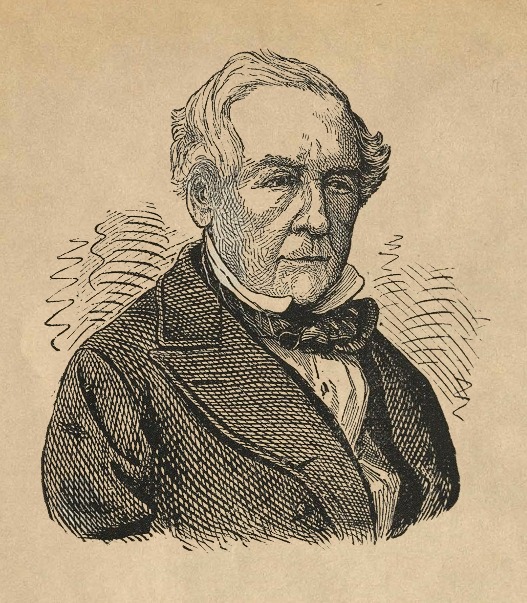
Edward Winter

Some comments by George Walker from pages x-xi of Chess Studies (London, 1844):
‘Mr Cochrane could have been the Philidor of the age; but would not. His ardent temperament, as a Chess-player, runs away with his judgment; disdaining to track a beaten path, even if certain victory present itself in the vista of the route. Mr Cochrane’s banner bears for its device, “Attack, attack”. – Attack at all risk – attack at every cost. Mr Cochrane is the most brilliant player I have ever had the honour to look over or confront; not even excepting De la Bourdonnais; and pity it is that his very brilliancy so often mars success.’
‘The somewhat severe – not to say cold – style of M. Popert’s game is more than counterbalanced by the talent he evinces for that vital principle of Chess – counter-attack. His judgment of position, too, is second to that of no man; and he plays endings with great mechanical accuracy.’
‘Speaking of ends of games, I must here observe, that of all players since Philidor, without exception, I believe Szén, of Hungary, conducts pawn-endings with the most deadly skill, as regards his adversary.’
Footnote on Cochrane: his obituary on page 84 of the 15 March 1878 issue of La Stratégie called him ‘the most brilliant player of the present century’.
(Kingpin, 1999)
From the beginning of Cochrane’s Preface (pages v-vi) to A Treatise on the Game of Chess (London, 1822):
‘When the imagination has been tamed down, by the analyzation of games, little can be expected from a writer on chess in the shape of elegance or even purity of expression: the present Work can pretend to neither. I have addressed myself merely to players who have some knowledge of the game, in a plain and, I hope, intelligible manner, without being particularly attentive to the minuter accuracies of language. Any one who has taken the trouble to examine a work upon chess is soon satisfied that the unvarying succession of technical phrases must tire and disgust the writer, and willingly extends that indulgence to his language which the constant repetition of terms renders absolutely necessary.’
(Kingpin, 2000)
‘… that slowest of encounters, the execrable French Defence – “King’s Pawn one sneak”, as Walker omits no opportunity of stigmatizing it; or “King to Pawn’s one”, as Leonard used derisively to style it.’
From page ix of Brevity and Brilliancy in Chess by Miron J. Hazeltine (New York, 1866).
(2253)
To help redress the balance, here is the view on 1…e6 expressed by Daniel Harrwitz on page 27 of his Lehrbuch des Schachspiels (Berlin, 1862):
‘This is the best game for the second player because he is exposed to no attack, and in a few moves the game is level.’
(2340)
Further support for the French Defence comes from John Cochrane on page 260 of A Treatise on the Game of Chess (London, 1822):
‘I now proceed to the consideration of a game which has been hastily passed over as bad by almost every writer on chess; say hastily, because they have evidently not given it that attention which its intricacy undoubtedly deserves: it is a game entirely of position, and, consequently, one of extreme difficulty. The attack, which is thrown into the hands of the second player, when the first endeavours to maintain his king’s and queen’s pawns in the centre, is a singular feature in it.’
On the next seven pages Cochrane analysed four lines, mainly beginning 1 e4 e6 2 d4 d5 3 e5 c5. It was not until the next decade that the name ‘French Defence’ was introduced; Cochrane called it the ‘King’s pawn one game’.
(2390)
From an article (unsigned) in the Chess World, 1865, pages 97-99:
‘… We could willingly banish from the chess state that servile reproduction of others’ thoughts and learning which marks the hackneyed player, and in its stead bring back again something like invention and original ability. Chessplayers of the present day study too much when away from, too little when at, the board.
… If players would but come to the game in the spirit rather than with the exact words of Lewis, they would in a short space of time do much more for the general cause of chess and for their own individual skill than they will ever do under the present vicious system. Amongst the brute creation, a donkey obeying nature is a most useful and valuable animal, but if dressed in a lion’s skin it becomes ridiculous, for, alas!, it cannot get rid of either its voice or its ears.
… We unhesitatingly assert that those players who aim at being most scientific, and place their chief reliance on a knowledge of openings, are not in the long run the most successful. Cochrane was more learned than Deschapelles, McDonnell than Labourdonnais, Löwenthal than Harrwitz; yet native wit triumphed. In the first of these instances the result is the more remarkable, because no more original player than Cochrane ever lived …’
(2507)
Marc Hébert (Charny, Canada) asks for information about one of John Cochrane’s Indian opponents who is featured in databases, Mahescandra. We take this to be a variant of Moheschunder (or Mohishunder), and advice will be welcomed on the rights and wrongs, if any, of these spellings.
The following appeared on pages 68-69 of A Century of British Chess by P.W. Sergeant (London, 1934):
‘Cochrane had gone back to India, and in 1848 we hear of him, as president of the Calcutta Chess Club (in the foundation of which he was largely instrumental), still seeking for opponents out East capable of testing the skill which he had so worthily proved in the West. One was at last found. A member of the club in the autumn of 1848 heard of a Brahman in the Mofussil – up country, as we might say – who had never been beaten at chess. He found an opportunity of meeting him, played him, and lost. It was stated that the man, “Moheschunder Bonnerjee, a Brahmin”, of about 50, hardly knew the European rules of chess; yet his play was presumably under European rules.
Delighted with his find, the Calcutta member took him back with him, and passed him on to Cochrane as an opponent. Cochrane beat him, but was sufficiently impressed with his skill to have him engaged as “a paid attaché” of the Chess Club, where he improved wonderfully. In the [Chess Player’s Chronicle] for 1851 are published some games between Cochrane and Moheschunder; and “the Brahmin” figures as a player in various collections of games. The Indian Defences by P-KKt3 coupled with P-Q3, or P-QKt3 coupled with P-K3, were largely taught to European players by the example of Moheschunder and other Indians, to whom the fianchetto developments were a natural legacy from their own game. The fondness for them of the present Indian champion of British chess, Mir Sultan Khan, is well known. But they are now so widely popular that Dr S.G. Tartakower was able to declare, some years ago, that “today fianchettos are trumps”. A sequel hardly to have been anticipated from the discovery of Moheschunder in the Mofussil.’
Sergeant’s information was largely based on a letter from a member of the Calcutta Chess Club on pages 318-319 of the 1850 Chess Player’s Chronicle, which included the following:
‘The only player here who has any chance whatever with Mr Cochrane, upon even terms, is a Brahmin of the name of Moheschunder Bonnerjee. Of this worthy, Mr Cochrane has himself remarked that he possesses as great a natural talent for chess as any player he ever met with, without one single exception.’
Some nineteenth-century references to ‘Indian’ in connection with openings, including a mention of Moheschunder, are given in the feature article Earliest Occurrences of Chess Terms.
The game below, from pages 154-155 of the 1854 Chess Player’s Chronicle, is an example of Cochrane’s attacking zeal:
John Cochrane – Moheschunder1 e4 d6 2 d4 Nf6 3 Nc3 e6 4 f4 Be7 5 Nf3 O-O 6 Be2 b6 7 O-O c5 8 dxc5 bxc5 9 Bd3 Nbd7 10 e5 dxe5 11 fxe5 Nd5 12 Ne4 Qc7 13 Nfg5 Nxe5 14 Nxh7 Nxd3 15 cxd3 Kxh7 16 Qh5+ Kg8 17 Rf3 e5 18 Rg3 f5
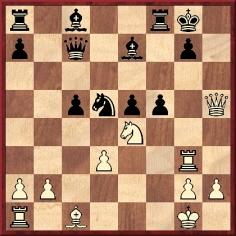
19 Rxg7+ Kxg7 20 Bh6+ Kh8 21 Bxf8+ Kg8 22 Bh6 Nf4 23 Qe8+ Kh7 24 Bxf4 fxe4 25 Qf7+ Kh8 26 Bg5 Bd8 27 Bf6+ Resigns.
Page 141 of Kings, Commoners and Knaves gave another win by Cochrane against the same opponent, contributed by Jack O’Keefe. He described it as ‘one of the most remarkable Grünfelds ever played’, given that it occurred not just before Grünfeld’s career but even before Morphy’s:
1 d4 Nf6 2 c4 g6 3 Nc3 d5 4 e3 Bg7 5 Nf3 O-O 6 cxd5 Nxd5 7 Be2 Nxc3 8 bxc3 c5 9 O-O cxd4 10 cxd4 Nc6 11 Bb2 Bg4 12 Rc1 Rc8 13 Ba3 Qa5 14 Qb3 Rfe8 15 Rc5 Qb6 16 Rb5 Qd8 17 Ng5 Bxe2 18 Nxf7 Na5 and White mates in three.
To quote the remainder of our earlier item:
‘According to the Chicago Tribune of 13 July 1879, which took the score from the Glasgow Herald, the game was played between Cochrane and Moheschunder in May 1855. It was also annotated by Steinitz in The Field of 6 June 1874 [page 565].’
This sketch of Cochrane by Samuel Loyd, based on a picture in the Westminster Papers, was published on page 1964 of the Scientific American Supplement, 11 May 1878:
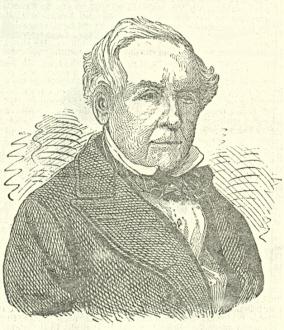
(5590)
John Townsend (Wokingham, England) writes:
‘The Inner Temple Admissions Database indicates that John Cochrane was admitted to the Inner Temple on 13 May 1819, the third son of the Honourable John Cochrane, of Edinburgh, that he was called to the Bar on 29 June 1824, and that he died on 2 March 1878.
“Honourable” was applied to untitled children of nobility. In the case of Cochrane’s father, the Honourable John Cochrane (1750-1801) was a son of Thomas Cochrane, the eighth Earl of Dundonald. He was a much-travelled man, and his children were born to several women. He was not married until 7 May 1800, when the marriage register of St Marylebone shows that he tied the knot as a bachelor with Selina Fitzroy Birch, a spinster, of Pinner, Middlesex. Neither of them lived long afterwards, and they left no surviving issue. Selina made her will (National Archives, PROB 11/1383/378) on 24 July 1801, and it was proved on 22 December 1802. Her husband was buried at St James’s Piccadilly on 26 October 1801. A short death notice in the Morning Post (29 October 1801, page 4) mentioned that he had died on 21 October at his house in Harley Street, Cavendish Square, “two months after the death of his beloved wife and infant son”.
The will of the Honourable John Cochrane (National Archives, PROB 11/1407/25) was written on 27 September 1801, while he was living in Harley Street, but was not proved until 6 April 1804. He named three (illegitimate) sons and a daughter (Angelique Cochrane). The first two sons were Nathaniel Day Cochrane and James Johnston [sic] Cochrane. Since the third son was John Cochrane, the information corroborates that obtained from the Inner Temple Admissions Database (see above), and that makes it possible to identify the chessplayer as the recipient of the following bequest:
“I give and bequeath unto John Cochrane the son of Margaret McDougal now living at Newhaven near Leith the like sum of one thousand pounds.”
Newhaven lies on the coast about two miles to the north of Edinburgh. It appears from this bequest that the chessplayer spent at least some of his early childhood there. Nothing is otherwise known of his mother, Margaret McDougal, although there is ample scope for further research, and especially if she left a will.
In 1826 John Cochrane received another gift of £1,000, this time from the brother of the Honourable John Cochrane, the Honourable Basil Cochrane, whose will (National Archives, PROB 11/1718/389) contained this:
“And I do hereby give and bequeath the sum of one thousand pounds Sterling to John Cochrane also the reputed Son of my said late Brother the Honourable John Cochrane.”
This immediately follows bequests to Nathaniel Day Cochrane and James Johnstone [sic] Cochrane, and therefore underlines the status of John Cochrane as the third son. The will was made on 7 June 1824, and probate was granted in London on 16 November 1826. The first two sons rose to senior positions in the navy and army respectively, while John Cochrane became a barrister.
Also to be found in the National Archives, and not so far examined, is a “probate inventory, or declaration, of the estate, with account”, of Hon. John Cochrane, deceased, of Harley Street, St Marylebone, dated March 1810 (PROB 31/1037/285).
The age of John Cochrane the chessplayer was given as 72 in the 1871 census (National Archives, RG 10/165, folio 48), his place of birth being entered as Edinburgh. At that time, he was living as a lodger in a boarding house at 32 Seymour Street, Marylebone, described as “Barrister in Practice”. In the same house were two women by the name of Emily Cochrane; their ages were given as “60” and “30-40”.
Cochrane’s age at the time of his death in the March quarter of 1878 was given as 78 in the death indexes at the General Register Office (ref. Marylebone, vol. 1A, page 444).
With that information it may be possible to find a baptism (or birth) record for the chessplayer during the approximate period 1798-1800, perhaps in Edinburgh, Newhaven or Leith. Such a search would be assisted by the knowledge that the mother was Margaret McDougal and the father the Honourable John Cochrane.
Cochrane was a most generous subscriber to the 1851 London tournament, as can be seen from pages xxxi and lix of Staunton’s The Chess Tournament (1852). In addition to his own donation of £20, he must also have played some part in a contribution of £100 in the name of the Calcutta Chess Club, of which he was the President. However, he was not a rich man when he died. His own will is referenced in the National Probate Calendar, which shows that he died on 2 March 1878 and that his personal estate was valued at under £200; the sole executrix was his niece, Emily Cochrane, a spinster, and the address of both was entered as 12 Bryanston Street, (which, incidentally, differs from the 6 Bryanston Street given for Cochrane’s death in the Inner Temple Admissions Database.) This Emily Cochrane was an illegitimate daughter of Nathaniel Day Cochrane, and was born on 13 October 1825, according to her baptism entry on 21 February 1828 in the parish register of St Marylebone.’
(11102)
Shortly after John Cochrane’s death, a tribute by I.O. Howard Taylor was published on page 2 of the Hartford Weekly Times, 4 April 1878. It was reproduced on pages 30-32 of the American Chess Journal, April 1878 and, thanks to the Cleveland Public Library, we give below the front cover and the frontispiece portrait of Cochrane in addition to the letter itself:
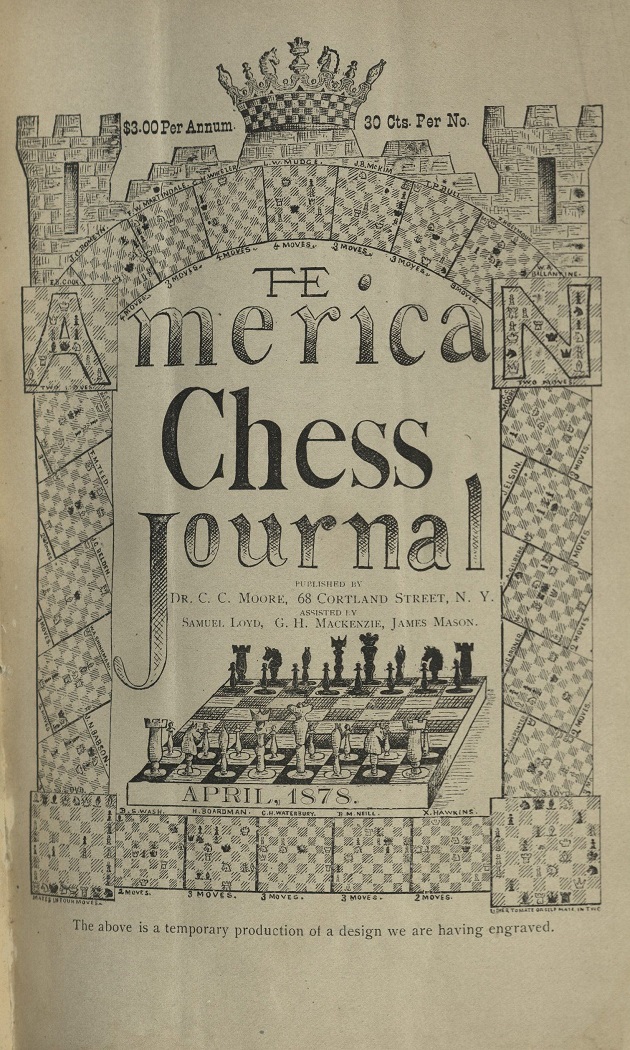
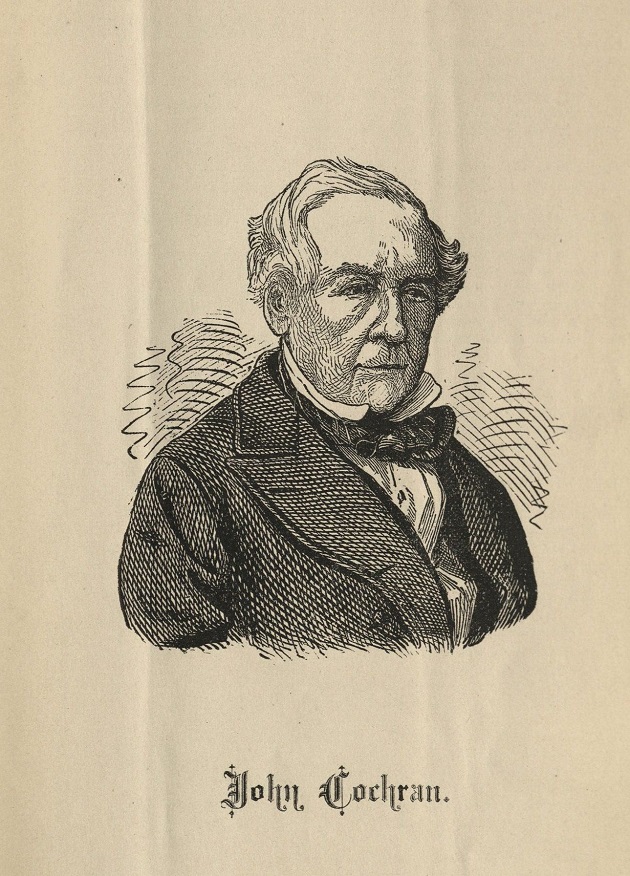
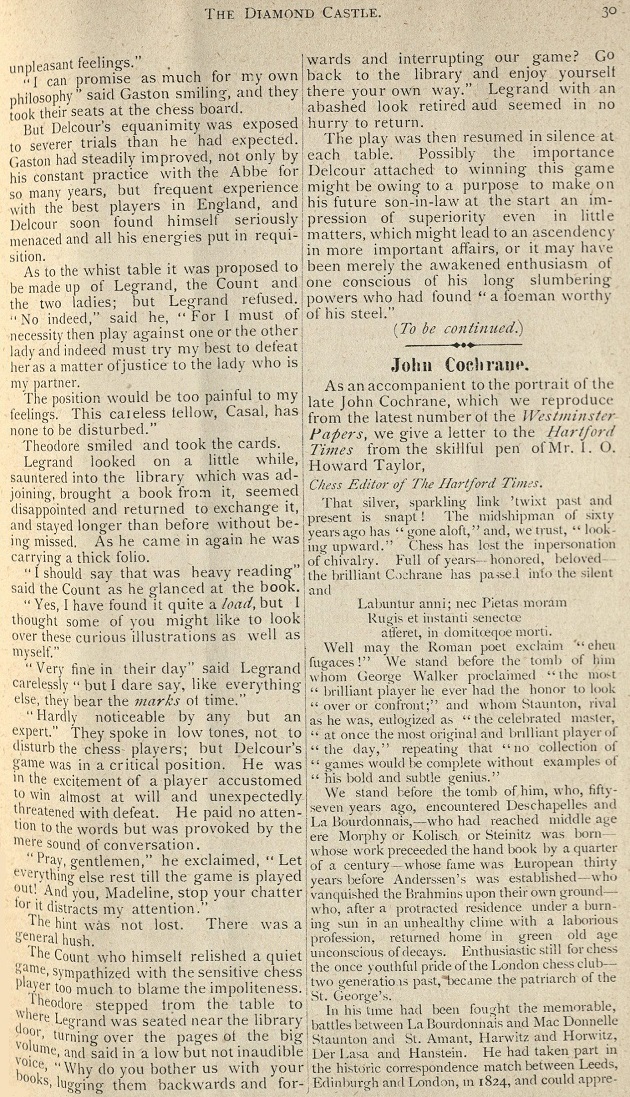
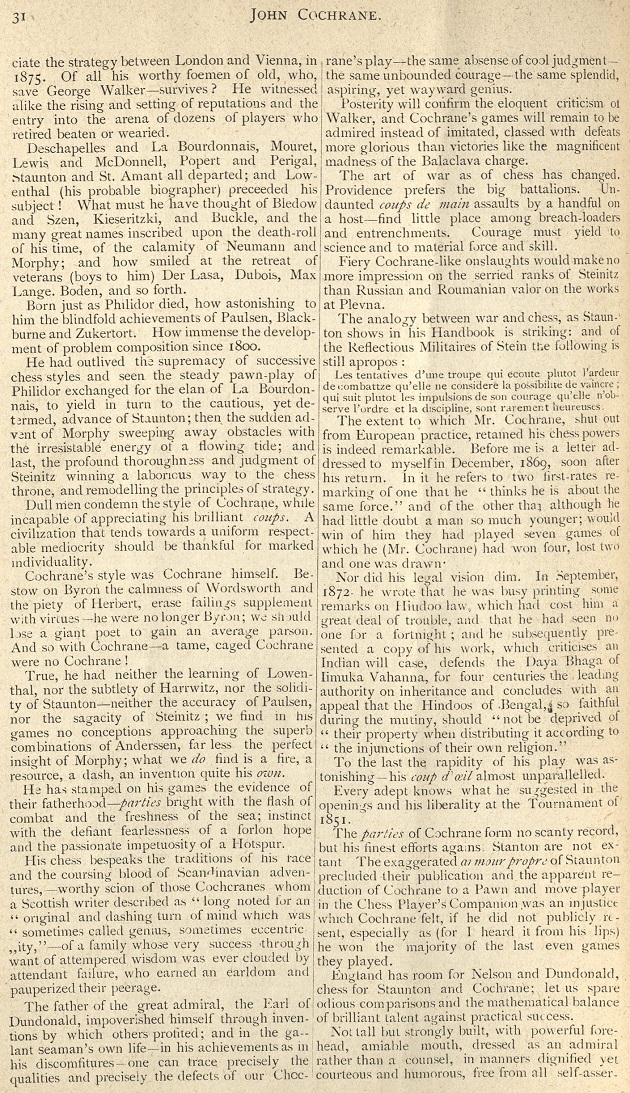
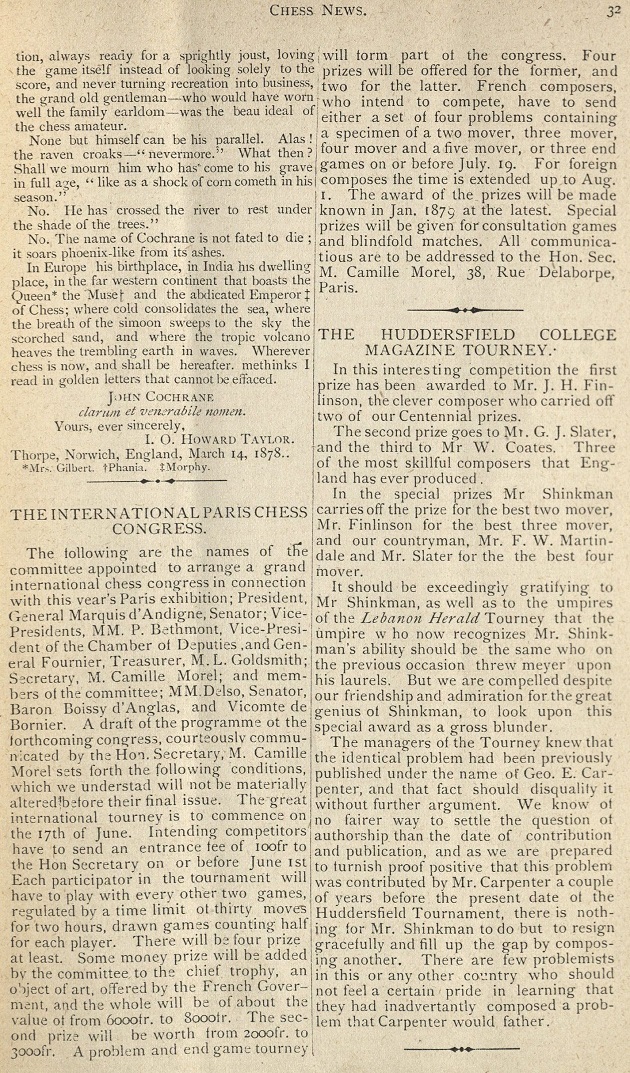
(11106)
From John Townsend:
‘The Royal Parks website makes it possible to search the burial register of Brompton Cemetery, and an image of the burial entry of John Cochrane shows that he was buried there on 8 March 1878. The address recorded was 12 Bryanston Street, Bryanston Square, and his age was given as 77, whereas 78 was specified in the death indexes of the General Register Office. The website also provides a link to an aerial view showing the location of the grave.
Does a memorial to Cochrane exist?’
(11392)
A further contribution from John Townsend:
‘A rare glimpse of John Cochrane as a midshipman is to be found in a personal memoir written by John Harvey Boteler (1796-1885). It suggests that Cochrane was already a conspicuously strong player when he served in the Royal Navy. The account, entitled Recollections of My Sea Life from 1808-1830, was printed for private circulation in 1883. Boteler was appointed to HMS Antelope as a Lieutenant on 3 October 1815. His description of the ship’s activities in the Leeward Islands, in the West Indies, contains the following passage on pages 75-76:
“We had a midshipman, John Cochrane, a very admirable chess player. The admiral, who was fond of the game and not by any means a bad hand at it, used to send for Cochrane, who would generally beat him two out of three. We always knew how the game went by the temper of the admiral, and once or twice we asked Cochrane to give him a game to put him in a good humour; this was no go. Cochrane would be outside the mids.’ mess-place and play two games with anyone without seeing the board, and it was marvellous how rapidly his skill got wind among the islands. Directly we anchored some challenge would come off for a trial of strength.”
Cochrane’s sparring partner was Rear-Admiral John Harvey (1772-1837), Boteler’s uncle.
John Cochrane’s service on HMS Antelope had ended by 13 May 1819, when, as was established in C.N. 11102, he was admitted to the Inner Temple.
Some obituaries state that he served as a midshipman on board the Bellerophon. However, they blot their copy-books if they go on to say that the Bellerophon conveyed Napoleon to St Helena, since it only took him to England. This lowers somewhat the credibility of the Bellerophon story, but the first part could still be true and he could have joined HMS Antelope after leaving the Bellerophon. A search in Bellerophon’s log (National Archives, ADM 53/192) in the period immediately before and after Napoleon’s capture, resulted in the following entry being noted, dated 13 July 1815:
“Received on Board Napoleon Buonaparte late Emperor of France.”
No mention of Cochrane was found, but, for a definitive answer to this Bellerophon uncertainty, the ship’s muster and pay records should be searched.
The Royal Navy had at least one other very strong player about this time in Lieutenant Harry Wilson. C.N.s 6506 and 6532, contributed by Rod Edwards, refer to Wilson’s having once given odds of a knight to Labourdonnais.’
(11896)
Also from Mr Townsend (contribution dated 24 April 2023):
‘John Cochrane’s will shows that it was made on 14 February 1873 and was witnessed by two clerks to Thomas Graham, a solicitor at the Temple.
It contains only one bequest:
“I devise and bequeath all my property real and personal to my dear niece Miss Emily Cochrane the daughter of my brother the late Admiral Cochrane for her own use for ever and I hereby appoint her Executrix ...”
The reference to his late brother, Nathaniel Day Cochrane, is further confirmation that John Cochrane’s father was the Honourable John Cochrane.
The grant of probate to Emily Cochrane was made on 2 April 1878 and indicates that the effects were under £200 and that there were no leaseholds. It also confirms the deceased’s date of death as 2 March 1878 and the place as 12 Bryanston Street, which was also the address of his executrix.
As was noted earlier, 6 Bryanston Street is recorded as Cochrane’s place of death in the Inner Temple Admissions Database. That was also given as his residence on page 38 of Boyle’s Court and Country Guide (corrected for April 1877). Boyle’s Court Guide for April 1878 (page 37) indicates that “Miss Cochrane” resided at 12 Bryanston Street.’
To the Chess Notes main page.
To the Archives for other feature articles.
Copyright: Edward Winter. All rights reserved.